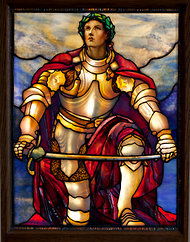 The article published on the website
of the newspaper “The New York Times” on December
31, 2012 is headlined “Spiritual Landscapes of the Gilded Age”. The
article repots that organized
by Patricia C. Pongracz, the museum’s acting director, and the exhibition’s
main attraction is a selection of 10 small- to medium-size windows, backlit and
glowing. They are not the most impressive of Tiffany productions, as his
most ambitious ones are still part of the fabric of churches all over
The article published on the website
of the newspaper “The New York Times” on December
31, 2012 is headlined “Spiritual Landscapes of the Gilded Age”. The
article repots that organized
by Patricia C. Pongracz, the museum’s acting director, and the exhibition’s
main attraction is a selection of 10 small- to medium-size windows, backlit and
glowing. They are not the most impressive of Tiffany productions, as his
most ambitious ones are still part of the fabric of churches all over
The article informs us that there are of three types: landscapes,
semiabstract cruciform compositions and figurative illustrations of biblical
scenes. All are made of opalescent glass, a material that Tiffany and his
competitor John La
Farge developed
through extensive experimentation that enabled variations of color, luminosity,
shading and texture unknown to stained-glass artisans of previous times.
It was revealed full descriptions of these types. The
landscape windows are the most compelling. They were designed by Agnes Northrop. In a style related to Art
Nouveau and Arts and Crafts, her windows picture peaceful vistas through groves
of trees and blooming foliage to brooks and still waters, mountains and
luminous, fair-weather skies. In
the more abstract works like one based on an antependium — a traditional type of banner, the profuse ornamental patterning and the
illuminated colored glass still exert much visual magnetism.
The figurative windows are
fatally infected by Victorian sentimentality. In one based on a popular
painting by the British artist George Frederic Watts, the
Christian knight Galahad— in a full suit of armor, pausing with his white horse
to meditate on his quest — is a vacuous doll.
The article informs us that viewers may also notice that there are no
representations of Jesus crucified or undergoing other agonies of the Passion. The
dark side of the Christian mythos — its preoccupation with sin, suffering,
judgment and redemption — is missing.
Many churches often
expanded to include spaces for educational programs, kitchens and dining rooms,
and bowling allies and basketball courts to attract the younger set.
I can say that Tiffany participated in the degradation
of art into decoration and religion into entertainment. His was the god of art
and business. But no one can deny that he oversaw the production of some
exceedingly beautiful things.
There is no link to the article in the web.
ОтветитьУдалитьThese are all your phrases concerning the cliche of the rendering:
1. The article repots
2. The article informs x2
3. It was revealed
Bad result (((
1. To my mind, 2. personally I think, 3. from my point of view, 4. I think instead of I can say